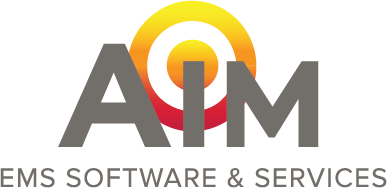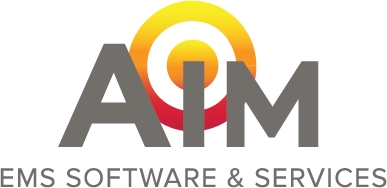-1.png?width=723&height=407&name=AIM%20Blog%20Header%20Images%20(1920%20%C3%97%201080%20px)-1.png)
Software that streamlines your dispatch, PCR, and billing functions is critical to running a successful EMS agency. But unless those solutions integrate with each other, you won’t get the full benefit of their functionality. And you won’t be able to maximize their ability to increase efficiency, optimize reimbursement, improve cash flow, and drive higher profitability.
Whether you choose EMS dispatch, ePCR, and billing software from the same vendor or you work with multiple providers, it’s essential to integrate these solutions to achieve a seamless, efficient operation. No matter the size or complexity of your EMS agency, a fully integrated approach will pay dividends that greatly improve your bottom line.
What an Integrated EMS Process Looks Like
Consider what happens between the time you receive a call and the time you submit the bill. At every step, your team needs accurate, complete data to perform their jobs effectively. They can’t waste time rekeying information that was already gathered earlier in the process, nor afford the errors that naturally result from manual data entry.
Integrating your EMS software creates a seamless, end-to-end process that delivers exactly what each staff member needs—to avoid time-consuming and error-prone duplicate data entry, ensure data integrity, and improve documentation quality. Here’s what the process looks like when it’s guided by integrated dispatch, ePCR, and billing software.
- When a 911 call comes in, dispatch collects essential information on the patient and the situation. That includes the many data points required to meet the NEMSIS standard for reporting, along with additional details that facilitate handling the call. The team can use the EMS dispatch software to enter data like the time of the call, the time the crew was notified, the pickup location, and much more. (If you use the software to create tailored workflows for scheduled vs emergency calls, call takers and dispatchers will find the intake process even simpler and faster!)
- When a crew is dispatched, they need all the rich detail your call taker or dispatcher collected in order to provide the best patient care, and to complete their patient care report (PCR). With an integrated solution, the data captured during dispatch automatically generates a record that’s easily accessible to the crew. No matter where they’re located when the call is assigned, they can access the software, select the record for this particular call, and all the data collected at dispatch will automatically import into the EMS ePCR software. Now, they have everything they need to provide exceptional patient care and develop an accurate, thorough PCR narrative.
- When the call is complete and it’s ready to be billed, the EMS billing team needs easy access to data that enables them to submit an accurate, thorough claim that will be approved and paid quickly. Some of that data is gathered during the call (such as patient demographics and insurance information) while other data is collected by the crew for the PCR narrative (including whether it’s a new patient or one who is already in your agency’s system). By leveraging all the data gathered along the way and following proven billing best practices, billers gain the full picture they need to get an accurate bill out the door fast, avoid costly rejections, and speed reimbursement.
Once you’ve integrated all your EMS software solutions, you can easily set up alerts and notifications that further improve the workflow.
For example, billers need to know when a PCR has gone through the QA process and the claim is ready for billing. When the ePCR and billing software are integrated, the biller can receive an automatic notification of an approved PCR, go into their assigned work queue, and begin working on the bill. There’s no delay in starting the work in progress and the claim out the door.
How to Optimize Your EMS Software Integration
The following best practices can help you avoid common EMS software integration pitfalls and achieve a seamless, efficient operation.
- Consider working with a single vendor. When one vendor provides EMS software to facilitate all three workflows—dispatch, PCR, and billing—the integration process becomes simpler. There’s no need to coordinate with multiple vendors, contact separate support teams, train your staff on disparate platforms, or pay recurring software interface update fees.
- Ensure every vendor can integrate with third parties. If you use EMS software from multiple vendors (for example, in a state that requires you to use a particular ePCR software solution), be sure every vendor you work with can easily integrate their software with others.
- Find out how much the vendor charges for integration services. Some EMS agencies have been hit with steep charges to integrate one vendor’s software to another’s package. Before choosing a vendor for EMS dispatch, ePCR, or billing software, ask how much they charge to integrate these solutions.
- Evaluate the vendor’s integration support. A smooth implementation and integration requires strong expertise in EMS software and responsive support. Assess whether the vendor is committed to making the integration work effectively and completing it in a reasonable timeframe, especially if you’re integrating software from multiple parties.
Get Fully Integrated EMS Software from AIM
AIM is your-one-stop shop for EMS software that improves efficiency, optimizes reimbursement, and increases profitability. Our EMS Dispatch, EMS ePCR, and EMS Billing Software can fully integrate with each other or with third-party applications, providing a seamless workflow that keeps your team working productively and effectively. That’s why leading EMS agencies choose AIM as their trusted partner for secure, cloud-based software that helps them succeed and thrive.
Schedule a demo and see how AIM’s integrated EMS Dispatch, EMS ePCR, and EMS Billing Software can boost your efficiency and profitability.



